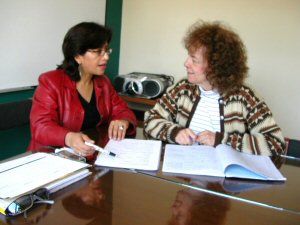Tandem Language Learning
Number One Best Tip:
How to get what you need
 Tandem language learning is a great way to practice and improve your new language. Working with a tandem is a language learning technique where you set up a formal or informal arrangement with another person to study languages together. Most often each person is a native speaker of a language and wants to learn the other persons language. You agree to have them teach you their language, and in exchange you teach them your language. Tandem language learning is a great way to practice and improve your new language. Working with a tandem is a language learning technique where you set up a formal or informal arrangement with another person to study languages together. Most often each person is a native speaker of a language and wants to learn the other persons language. You agree to have them teach you their language, and in exchange you teach them your language.
Sometimes tandems are arranged through a language school, for example when Terry and Ann were in Peru, they each worked with a tandem to improve their Spanish. Terry worked with Mariarosa, and Ann partnered with Juan. Even if you aren't studying with a language school you can arrange your own tandem language learning.
Tandem language learning takes the mentor concept that we teach in Walkabout Language Learning one step further.
LiveMocha is a website that allows language learners from around the world to connect. They provide lessons and opportunities to record your answers to be reviewed by native speakers. Users can chat online with speakers of other languages. LiveMocha is one way to connect with speakers of other languages, if you don't know any personally.
The most important factor to getting the most out of tandem language learning is knowing what you want.
One challenging aspects of tandem language learning is that it is easy to fall into the trap of speaking unequally in one language or the other. Before you start your tandem sessions, set clear expectations with your partner about how you will work together. For example, you may decide that you'll study and speak your language for 30 minutes and then study their language for 30 minutes. Then, stick to your plan. If necessary, use a timer to remind you to switch languages.
You may decide on a more flexible format. For example, I created a tandem arrangement to teach a family English. We studied English for thirty minutes to an hour; then they fed me dinner. While we ate, we conversed informally in Spanish and I got my Spanish tutorial. They wanted formal grammar lessons and practice reading in English. I wanted to improve my speaking and listening skills.
It is important to know what you want to get out of the experience because it is easy to fall into the trap of speaking your own language because it is easier. I recently interacted with a tandem language learner through LiveMochas chat feature. Initially, he contacted me. He stared with a couple sentences, one in English, the second in Spanish. I replied half English, half Spanish. After a couple exchanges, the conversation turned exclusively into English.
I had gone into the conversation without a clear idea of what I wanted from our LiveMocha chat. Had I thought about it ahead of time, I would have decided that I would speak only the target language, or I would have made an agreement with the other individual to speak English for a set period of time then Spanish for a set period of time.
If you do find a tandem partner through a chat program you may decide to meet regularly to practice your language learning. This gives you more time to practice your skills in both languages so that both partners benefit.
Tandem language learning can be a great way to improve your skills in another language. Be sure that you know what you want from your language learning sessions before you start, and set clear expectations with your partner.
To read other creative ideas about language learning, check out Owen Lee's Ultimate Language Secrets. Read our review here.
Return from Tandem Language Learning to Language Learning Strategies
Return to Your Language Guide home
|



 Tandem language learning is a great way to practice and improve your new language. Working with a tandem is a language learning technique where you set up a formal or informal arrangement with another person to study languages together. Most often each person is a native speaker of a language and wants to learn the other persons language. You agree to have them teach you their language, and in exchange you teach them your language.
Tandem language learning is a great way to practice and improve your new language. Working with a tandem is a language learning technique where you set up a formal or informal arrangement with another person to study languages together. Most often each person is a native speaker of a language and wants to learn the other persons language. You agree to have them teach you their language, and in exchange you teach them your language.
New! Comments
Have your say about what you just read! Leave me a comment in the box below.